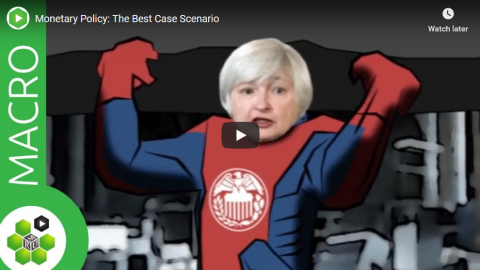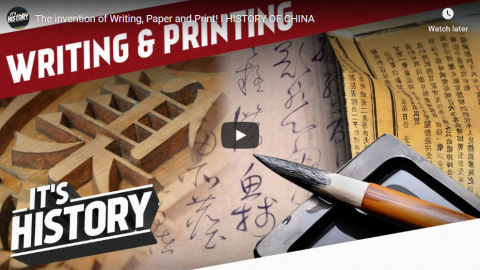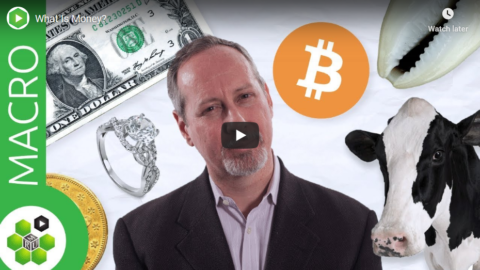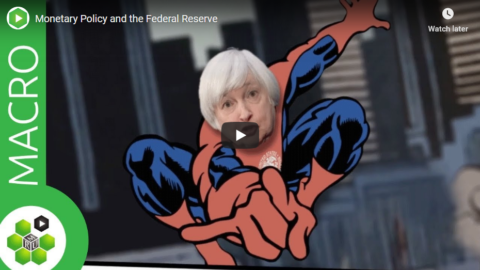A crucial part of the Anabaptist reign of terror was their decision, again prefiguring that of the Khmer Rouge regime in Cambodia, to abolish all private ownership of money. With no money to purchase any good, the population became slavishly dependent on handouts or rations from the power elite. Accordingly, Matthys, Rothmann, and the rest launched a propaganda campaign that it was un-Christian to own money privately; and that all money should be held “in common,” which in practice meant that all money whatsoever must be handed over to Matthys and his ruling clique…
After two months of unremitting propaganda, combined with threats and terror against those who disobeyed, the private ownership of money was effectively abolished in Münster. The government seized all the money and used it to buy goods or hire workers from the outside world. Wages were doled out in kind by the only employer: the theocratic Anabaptist State.
Food was confiscated from private homes, and rationed according to the will of government deacons. Also, to accommodate the host of immigrants, all private homes were effectively communized, with everyone permitted to quarter themselves everywhere; it was now illegal to close, let alone lock, one’s doors. Compulsory communal dining halls were established, where people ate together to the readings from the Old Testament.
The compulsory communism and reign of terror was carried out in the name of community and Christian “love.” This communization was considered the first giant step toward egalitarian communism, where, as Rothmann put it, “all things were to be in common, there was to be no private property and nobody was to do any more work, but simply trust in God.” Somehow, the workless part never seemed to arrive.
[…]
Totalitarianism in Münster was now complete. Death was now the punishment for virtually every independent act. Capital punishment was decreed for the high crimes of murder, theft, lying, avarice, and quarrelling. Death was also decreed for every conceivable kind of insubordination: the young against the parents, wives against their husbands, and, of course, anyone at all against the chosen representative of God on earth, the government of Münster. Bernt Knipperdollinck was appointed high executioner to enforce the decrees.
The only aspect of life previously left untouched was sex, and this deficiency was now made up. The only sexual relation now permitted by the Bockelson regime was marriage between two Anabaptists. Sex in any other form, including marriage with one of the “godless,” was a capital crime.
But soon Bockelson went beyond this rather old-fashioned credo, and decided to enforce compulsory polygamy in Münster. Since many of the expellees had left their wives and daughters behind, Münster now had three times as many marriageable women as men, so that polygamy had become technically feasible. Bockelson convinced the other, rather startled preachers by citing polygamy among the patriarchs of Israel, reinforcing this method of persuasion by threatening any dissenters with death.
Compulsory polygamy was a bit much for many of the Münsterites, who launched a rebellion in protest. The rebellion, however, was quickly crushed and most of the rebels put to death […]
The rest of the male population also began to take enthusiastically to the new decree. Many of the women reacted differently, however, and so the Elders passed a law ordering compulsory marriage for every woman under (and presumably also over) a certain age, which usually meant becoming a compulsory third or fourth wife.
Since marriage among the godless was not only invalid but also illegal, the wives of the expellees became fair game, and they were forced to “marry” good Anabaptists. Refusal of the women to comply with the new law was punishable, of course, with death, and a number of women were actually executed as a result.
Murray N. Rothbard, “Karl Marx as Religious Eschatologist”, Mises Institute, 2009-10-09.
November 3, 2019
QotD: The theocratic Anabaptist State of Münster
October 24, 2019
Monetary Policy: The Best Case Scenario
Marginal Revolution University
Published on 8 Aug 2017Imagine that you’re the Fed and the economy’s been doing fine. GDP growth is good, inflation is low. But then something happens. Consumer confidence drops. The economy shrinks.
What do you do?
October 5, 2019
Legends Summarized: El Dorado
Overly Sarcastic Productions
Published 4 Oct 2019El Dorado! A shining golden city packed with promises of wealth, power and everlasting glory. An unspoiled paradise deep in the jungle, the PERFECT destination for treasure-hunters and anthropologists alike. Something that perfect is something EVERYONE wants to be real.
Aaaaand that’s the trick, isn’t it? Wanting something that badly isn’t healthy. Just ask the conquistadors!
(Oh wait, we can’t – because so many of them died on fruitless quests for El Dorado. And also it’s been five hundred years and they’d all be dead anyway)PATREON: https://www.Patreon.com/OSP
MERCH LINKS: https://www.redbubble.com/people/OSPY…
OUR WEBSITE: https://www.OverlySarcasticProductions.com
Find us on Twitter https://www.Twitter.com/OSPYouTube
Find us on Reddit https://www.Reddit.com/r/OSP/
September 18, 2019
The invention of Writing, Paper and Print! l HISTORY OF CHINA
IT’S HISTORY
Published on 22 Jul 2015The invention of script, paper and printing can be credited to the Chinese. It was in China that Cai Lun, in his emperor’s service, made the production of paper suitable for the masses. Originally planned as a means to wrap things in, it soon became obvious that paper was more suitable for writing than the common bamboo stick. Guy explains how the Chinese printed written pages long before Gutenberg was born, how Chinese writing actually works and how emperor Qin tried to establish the standardized Chinese Han Characters, or Hanzi, attempting to unify the writing symbols for his country.
» SOURCES
Videos: British Pathé (https://www.youtube.com/user/britishp…)
Pictures: mainly Picture Alliance
Content:
Faulmann, Carl (1995): Schriftzeichen und Alphabete aller Zeiten und Völker. Augsburg. Reprint der Originalausabe von 1880 Wien.
Pan, Jixing (1998): “On the origin of movable metal-types”. In: Chinese Science Bulletin 43 (20).
Wai Wong (2005): “Typesetting Chinese. A personal perspective”. In: TUGboat 26 (2) 111-114.
https://www.tug.org/TUGboat/tb26-2/wo…
Yan, Yangtse (2006): “New Evidence suggests longer paper making history in China”. http://news.xinhuanet.com/english/200…» ABOUT US
IT’S HISTORY is a ride through history – Join us discovering the world’s most important eras in IN TIME, BIOGRAPHIES of the GREATEST MINDS and the most important INVENTIONS.» HOW CAN I SUPPORT YOUR CHANNEL?
You can support us by sharing our videos with your friends and spreading the word about our work.» CAN I EMBED YOUR VIDEOS ON MY WEBSITE?
Of course, you can embed our videos on your website. We are happy if you show our channel to your friends, fellow students, classmates, professors, teachers or neighbors. Or just share our videos on Facebook, Twitter, Reddit etc. Subscribe to our channel and like our videos with a thumbs up.» CAN I SHOW YOUR VIDEOS IN CLASS?
Of course! Tell your teachers or professors about our channel and our videos. We’re happy if we can contribute with our videos.» CREDITS
Presented by: Guy Kiddey
Script by: Martin Haldenmair
Translated by: Guy Kiddey
Directed by: Daniel Czepelczauer
Director of Photography: Markus Kretzschmar
Music: Markus Kretzschmar
Sound Design: Bojan Novic
Editing: Markus KretzschmarA Mediakraft Networks original channel
Based on a concept by Florian Wittig and Daniel Czepelczauer
Executive Producers: Astrid Deinhard-Olsson, Spartacus Olsson
Head of Production: Michael Wendt
Producer: Daniel Czepelczauer
Social Media Manager: Laura Pagan and Florian WittigContains material licensed from British Pathé
All rights reserved – © Mediakraft Networks GmbH, 2015
August 1, 2019
What Is Money?
Marginal Revolution University
Published on 18 Jul 2017That may seem like a really simple question, but it’s actually kind of complicated. Paper bills and coins, or currency, is obviously money. But it doesn’t end there.
Technically, “money” is anything that is a widely accepted means of payment. This has changed throughout history. Once upon a time, cattle could be considered money. Or cowry shells. Today, cryptocurrencies like Bitcoin are being added to the mix.
Given that there’s no set definition for what makes a commodity money, there are a few measurements for the U.S. money supplies. The first, MB (or “monetary base”) measures currency and reserve deposits. This is what the Fed has the most direct control over.
Our next stop will be fractional reserve banking and the money multiplier.
July 25, 2019
Monetary Policy and the Federal Reserve
Marginal Revolution University
Published on 11 Jul 2017Spider-Man fans likely recall Uncle Ben advising his nephew, Peter Parker, that “With great power, comes great responsibility.”
As it turns out, that sage wisdom is also pretty applicable to the U.S. Federal Reserve System (aka the Fed). The Fed Chairperson, currently Janet Yellen, may not shoot webs out of her wrists, but she and the organization she represents have some super powers over our money supply.
The Fed also has quite a few limitations – monetary policy can only do so much. We’ve previously covered the quantity theory of money and long- and short-run economic growth. If you think back to those videos, you’ll remember that an increase in the money supply (which, in the U.S., is controlled by the Fed) only affects growth in the short-run. Even then, it’s often not smooth sailing.
In this video, we’ll give you an introduction to the function of the Fed as well as some of the problems it faces, and raise the question, “What is money?”
May 24, 2019
Game of Theories: The Monetarists
Marginal Revolution University
Published on 14 Nov 2017Meet the monetarists! This business cycle theory emphasizes the effect of the money supply and the central bank on the economy. Formulated by Nobel Laureate Milton Friedman, it’s a “goldilocks” theory that argues for a steady rate of fairly low inflation to keep the economy on track.
April 12, 2019
QotD: Money is not wealth
If you want to create wealth, it will help to understand what it is. Wealth is not the same thing as money.* Wealth is as old as human history. Far older, in fact; ants have wealth. Money is a comparatively recent invention.
Wealth is the fundamental thing. Wealth is stuff we want: food, clothes, houses, cars, gadgets, travel to interesting places, and so on. You can have wealth without having money. If you had a magic machine that could on command make you a car or cook you dinner or do your laundry, or do anything else you wanted, you wouldn’t need money. Whereas if you were in the middle of Antarctica, where there is nothing to buy, it wouldn’t matter how much money you had.
Wealth is what you want, not money. But if wealth is the important thing, why does everyone talk about making money? It is a kind of shorthand: money is a way of moving wealth, and in practice they are usually interchangeable. But they are not the same thing, and unless you plan to get rich by counterfeiting, talking about making money can make it harder to understand how to make money.
Money is a side effect of specialization. In a specialized society, most of the things you need, you can’t make for yourself. If you want a potato or a pencil or a place to live, you have to get it from someone else.
How do you get the person who grows the potatoes to give you some? By giving him something he wants in return. But you can’t get very far by trading things directly with the people who need them. If you make violins, and none of the local farmers wants one, how will you eat?
The solution societies find, as they get more specialized, is to make the trade into a two-step process. Instead of trading violins directly for potatoes, you trade violins for, say, silver, which you can then trade again for anything else you need. The intermediate stuff — the medium of exchange — can be anything that’s rare and portable. Historically metals have been the most common, but recently we’ve been using a medium of exchange, called the dollar, that doesn’t physically exist. It works as a medium of exchange, however, because its rarity is guaranteed by the U.S. Government.
The advantage of a medium of exchange is that it makes trade work. The disadvantage is that it tends to obscure what trade really means. People think that what a business does is make money. But money is just the intermediate stage — just a shorthand — for whatever people want. What most businesses really do is make wealth. They do something people want.**
* Until recently even governments sometimes didn’t grasp the distinction between money and wealth. Adam Smith (Wealth of Nations, v:i) mentions several that tried to preserve their “wealth” by forbidding the export of gold or silver. But having more of the medium of exchange would not make a country richer; if you have more money chasing the same amount of material wealth, the only result is higher prices.
** There are many senses of the word “wealth,” not all of them material. I’m not trying to make a deep philosophical point here about which is the true kind. I’m writing about one specific, rather technical sense of the word “wealth.” What people will give you money for. This is an interesting sort of wealth to study, because it is the kind that prevents you from starving. And what people will give you money for depends on them, not you.
When you’re starting a business, it’s easy to slide into thinking that customers want what you do. During the Internet Bubble I talked to a woman who, because she liked the outdoors, was starting an “outdoor portal.” You know what kind of business you should start if you like the outdoors? One to recover data from crashed hard disks.
What’s the connection? None at all. Which is precisely my point. If you want to create wealth (in the narrow technical sense of not starving) then you should be especially skeptical about any plan that centers on things you like doing. That is where your idea of what’s valuable is least likely to coincide with other people’s.
Paul Graham, “How to Make Wealth”, Paul Graham, 2004-04.
March 16, 2019
MMT – Magic Money Theory
Antony Davies and James R. Harrigan explain just why so many progressives are so excited about MMT:
Modern Monetary Theory, or MMT, is all the rage in the halls of Congress lately.
To hear the Progressive left tell it, MMT is not unlike a goose that keeps laying golden eggs. All we have to do is pick up all the free money. This is music to politicians’ ears, but Fed Chairman Jerome Powell is singing a decidedly different tune. Said Powell recently on MMT, “The idea that deficits don’t matter for countries that can borrow in their own currency … is just wrong.”
MMT advocates see this as outdated thinking. We can, they claim, spend as much as we want on whatever we want, unencumbered by trivialities like how much we have. But MMT is a bait-and-switch wrapped in a sleight-of-hand. It focuses on debt and dollars rather than resources and products. Debt and dollars are merely tools we use to transfer ownership of resources and products. It’s the resources and products that matter. Shuffling debt and dollars merely changes the ownership of resources and products. It doesn’t create more.
[…]
So here’s the sleight of hand. MMT advocates say that we won’t experience inflation because the U.S. dollar is a reserve currency — foreigners hold lots of U.S. dollars. First, increasing the money supply, other things constant, does create inflation. But when a reserve currency inflates, the pain gets spread around the world instead of being concentrated within one country. In short, MMT advocates believe our government should print money and let foreigners bear some of the inflation pain. Second, there’s no law that says that the U.S. dollar must be a reserve currency. The British Pound was one, but as its value declined, foreigners stopped holding it. Foreigners will stop holding U.S. dollars too as their value declines.
And here’s the bait-and-switch. MMTers say that if inflation does become a problem, the government can simply raise tax rates to soak up excess dollars. In short, the government would print money with one hand, buying whatever it wants and causing inflation. It would then tax with the other, thereby removing dollars from the economy and counteracting the inflation. In the end, all that’s happened is that the government has replaced goods and services that people want with goods and services politicians want.
After a bout of MMT, we might have the same GDP and zero inflation, but what constitutes that GDP would have changed dramatically. Instead of having more cars and houses, we might have more tanks and border walls.
March 5, 2019
Changes in Velocity
Marginal Revolution University
Published on 16 May 2017What happens when aggregate demand shifts because of a change in the velocity of money? You’ll recall from earlier videos that an increase or decrease in velocity means that money is changing hands at a faster or slower rate.
Changes in velocity are temporary, but they can still cause business fluctuations. For instance, say that consumption growth slows as consumers become pessimistic about the economy.
In fact, we saw this play out in 2008, when workers and consumers became afraid that they might lose their jobs during the Great Recession. This fear drove them to cut back on their spending in the short run. But, since changes in velocity are temporary, this fear receded as time passed and the economy began to recover.
Dive into this video to learn more about what causes shifts in the aggregate demand curve.
January 20, 2019
The Short-Run Aggregate Supply Curve
Marginal Revolution University
Published on 9 May 2017In this video, we explore how rapid shocks to the aggregate demand curve can cause business fluctuations.
As the government increases the money supply, aggregate demand also increases. A baker, for example, may see greater demand for her baked goods, resulting in her hiring more workers. In this sense, real output increases along with money supply.
But what happens when the baker and her workers begin to spend this extra money? Prices begin to rise. The baker will also increase the price of her baked goods to match the price increases elsewhere in the economy. As prices increase, workers demand higher wages to be able to afford goods at a higher price.
In this example, the increase in money supply initially increased nominal and real wages for the baker and her employees, but as prices begin to rise, real wages begin to fall, and workers can afford less. Overtime, the demand for the baker’s goods will fall to pre-spending levels.
The takeaway? An increase in spending can increase output and growth in the short run, but not in the long run. To model this scenario, this video will show you how to draw a short-run aggregate supply curve. Let’s get started!
November 23, 2018
The Aggregate Demand Curve
Marginal Revolution University
Published on 18 Apr 2017This wk: Put your quantity theory of money knowledge to use in understanding the aggregate demand curve.
Next wk: Use your knowledge of the AD curve to dig into the long-run aggregate supply curve.
The aggregate demand-aggregate supply model, or AD-AS model, can help us understand business fluctuations. In this video, we’ll focus on the aggregate demand curve.
The aggregate demand curve shows us all of the possible combinations of inflation and real growth that are consistent with a specified rate of spending growth. The dynamic quantity theory of money (M + v = P + Y), which we covered in a previous video, can help us understand this concept.
We’ll walk you through an example by plotting inflation on the y-axis and real growth on the x-axis — helping us draw an aggregate demand curve!
Next week, we’ll combine our new knowledge on the AD curve with the long-run aggregate supply curve. Stay tuned!
October 13, 2018
Why Governments Create Inflation
Marginal Revolution University
Published on 14 Feb 2017Inflation can carry with it quite a few costs. But some governments, like Zimbabwe under President Robert Mugabe in the early 2000s, will go out of their to way to create inflation. Why?
Well, in the Zimbabwe example, the government printed the money and used it to buy goods and services. The ensuing hyperinflation acted as a tax that transferred wealth from the citizens to the government.
However, this is a fairly uncommon reason. Inflation doesn’t make for a good tax and it’s a last resort for desperate governments that are otherwise unable to raise funds.
There are other benefits to inflation that would make governments want to create it. In the short run, inflation can actually boost economic output. However, as we’ve previously covered, an increase in the money supply leads to an equal increase in prices in the long run.
If there’s a recession, governments might create inflation to spur productivity and ease the economic downturn. However, this type of inflationary boosting can be abused. Long-term boosting causes people to simply expect and prepare for it.
Reducing inflation is also costly. If the process is reversed and the growth in the money supply decreases, we get disinflation. Unemployment will likely increase in the short run and an economy can go through a recession. But in the long run, prices will adjust as well.
Inflation can be a neat trick for governments to boost productivity in an economy. But it can easily get out of hand and has even been likened to a drug. Once you start, you need more and more. And stopping is awfully painful as the economy shrinks.
This concludes our section on Inflation and the Quantity Theory of Money. Up next in Principles of Macroeconomics, we’ll be digging into Business Fluctuations.
September 6, 2018
Costs of Inflation: Price Confusion and Money Illusion
Marginal Revolution University
Published on 2 Feb 2017The inflation rate can be somewhat volatile and unpredictable. For example, let’s take the period between 1964 and 1983 in the U.S. The inflation rate jumped around from 1.3% in 1964 to 5.9% in 1970, and all the way up to 14% in in 1980, before dipping back down to 3% in 1983. These dramatic changes, though still fairly mild in the realm of inflation, caught people off-guard.
Peru’s inflation rates in the late 1980s through the early 1990s were on even more of a rollercoaster. Clocking in at 77% in 1986, its inflation rate was already quite high. But by 1990, it had jumped to 7,500%, only to fall to 73% a mere two years later.
High and volatile inflation rates can wreak havoc on the price system where prices act as signals. If the price of oil rises, it signals scarcity of that product and allows consumers to search for alternatives. But with high and volatile inflation, there’s noise interfering with this price signal. Is oil really more scarce? Or are prices simply rising? This leads to price confusion – people are unsure of what to do and the price system is less effective at coordinating market activity.
Money illusion is another problem associated with inflation. You’ve likely experienced this yourself. Think of something that you’ve noticed has gotten more expensive over the course of your lifetime, such as a ticket to the movies. Is it really that going out the movies has become a pricier activity, or is it the result of inflation? It’s difficult for us to make all of the calculations to accurately compare rising costs. This is known as “money illusion” – or when we mistake a change in the nominal price with a change in the real price.
Inflation, especially when it’s high and volatile, can result in some costly problems for everyone. Next up, we’ll look at how it redistributes wealth and can break down financial intermediation.
August 20, 2018
Causes of Inflation
Marginal Revolution University
Published on 24 Jan 2017In the last video, we learned the quantity theory of money and its corresponding identity equation: M x V = P x Y
For a quick refresher:
•M is the money supply.
•V is the velocity of money.
•P is the price level.
•And Y is the real GDP.
In this video, we’re rewriting the equation slightly to divide both sides by Y and explore the causes behind inflation. What we discover is that a change in P has three possible causes – changes in M, V, or Y.
You probably know that prices can change a lot, even over a short period of time.
Y, or real GDP, tends to change rather slowly. Even a seemingly small jump or fall in Y, such as 10% in a year, would signal astonishing economic growth or a great depression. Y probably isn’t our usual culprit for inflation.
V, or the velocity of money, also tends to be rather stable for an economy. The average dollar in the United States has a velocity of about 7. That may fall or rise slightly, but not enough to influence prices.
That leaves us with M. Changes in the money supply are the driving factor behind inflation. Put simply, when more money chases the same amount of goods and services, prices must rise.
Can we put this theory to the test? Let’s look at some real-world examples and see if the quantity theory of money holds up.
In Peru in 1990, hyperinflation came into full swing. If we track the growth rate of the money supply to the growth rate of prices, we can see that they align almost perfectly on a graph with both clocking in around 6,000% that year.
If we plot the growth rates of the money supply along with the growth rates of prices for a many countries over a long stretch of time, we can see the same relationship.
We’ll wrap-up the causes of inflation with three principles to keep in mind as we continue exploring this topic:
•Money is neutral in the long run: a doubling of the money supply will eventually mean a doubling of the price level.
•“Inflation is always and everywhere a monetary phenomena.” – Milton Friedman
•Central banks have significant control over a nation’s money supply and inflation rate.








